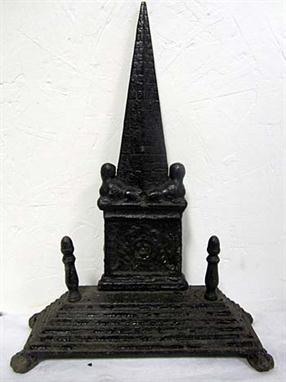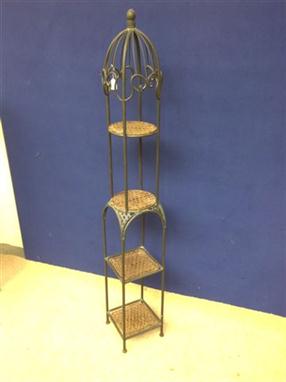ENGLISH SCHOOL, EARLY 18TH CENTURYALLEGORICAL PORTRAIT OF A LADYseated three quarter length in a blue mantle with a sandglass, obelisk and other buildings beyond, panel, 29 x 40cmProvenance: The Hon Catherine Harpur (1682-1744/5), daughter of Thomas, 2nd Lord Crewe of Stene and widow of Sir John Harpur, 4th Baronet, of Calke Abbey, Derbyshire. Specifically bequeathed by her will (written on 6 June 1743) to her daughter, Lady Jemima Palmer (d1768) wife of Sir Thomas Palmer of Carlton Curlieu, Leicestershire.This fascinating rediscovery of a picture known only from its description in Catherine Harpur`s will left Calke Abbey, that quintessential time capsule of a grand house, at an early date. In her Will the testatrix describes the present painting as "A picture with a Lady reading with an hour Glass ...". This is confirmed by the label verso presumably written by her son and which is signed with the initials TP and dated, probably, January [17]83. The present picture, which was clearly regarded as one of some importance would have hung at Calke Abbey (National Trust) and, possibly on account of its small size, was amongst a number of items of special personal significance taken with her when Lady Harpur removed to Luffenham, Rutland on the death of her husband in 1741.The contemplative pose, open book (in which can just be made out the letters `a n and t` and 29) sandglass, butterfly, bird and obelisk all vanitas symbols of the emptiness of earthly life irrespective of wealth or status.A portrait of the Hon Catherine Crewe, Lady Harpur with one of her children by Charles Jervas (c1675-1739) is at Calke Abbey (National Trust).++Localised instability of the medium with a few small spots of flaking near the sitter`s left leg, localised bitumenisation principally around the sitter`s left elbow, the varnish very dirty, the support in excellent condition free from shrinkage cracks or warping and long undisturbed in the present early 18th c ebonised frame which could well be original
We found 3310 price guide item(s) matching your search
There are 3310 lots that match your search criteria. Subscribe now to get instant access to the full price guide service.
Click here to subscribe- List
- Grid
A PAIR OF ITALIAN GRAND TOUR SPECIMEN MARBLE OBELISKS20th CenturyThe black marble is inlaid in geometric forms with sienna surrounding lapis lazuli, sienna, rouge, verte, gris, oxblood and others are inlaid into the expected obelisk forms raised on rectangular columns and square plinth base with ogee edge.Condition: Minor scratches to marble. Minor repair to top of one obelisk.21½ x 6½ x 6½ inches (54.6 x 16.5 x 16.5 cm).Two pieces total. Starting Price: $1,100.00
Cheselden (William). Osteographia, Or the Anatomy of the Bones, 1st edition, 1733, engraved frontispiece, title with engraved vignette, engraved royal arms on separate sheet, engraved dedication, (with deer skeleton to verso), 29 engraved illustrations, 112 engraved plates (complete), comprising two sets of plates numbered I-LVI by Jacob Schijnvoet and Gerard van der Gucht, first set lettered with explanatory text to verso, second set unlettered and without text, plate LVI of first set with deer skeleton to verso; plate LVI of the second set with obelisk ruin in red, historiated initials, occasional light spotting and toning, endpapers renewed, hinges reinforced, contemporary half calf, rebacked, corners chipped, folio. The most famous and among the most artistically interesting osteological atlases ever produced` (Norman), the first full and accurate description of human skeletal anatomy. One of only 400 copies, `which being finished, the plates shall be destroyed that the price of the book may never sink in the possession of the subscribers` (from To the Reader`). The accuracy of the drawing of the large plates of bones is derived from Cheselden`s innovative use of the camera obscura (the use of which is depicted on the title vignette and used for the first time solely for book illustration). The thick paper and large folio format allowed for life-size illustrations of separate human bones. William Cheselden (1688-1752) studied anatomy under William Cowper (1666-1709), becoming full surgeon at St Thomas`s Hospital in 1720. A pioneer of surgical techniques in bladder stone removal and ophthalmics, he is credited with performing the first known successful case of restorative eye surgery on a blind 13-year-old boy, an iridotomy, using a cataract-extraction knife to create an artificial pupil. G-M 395; Norman 466; Waller 1941. (1)
A folder of various rare Yu-Gi-Oh! cards including Exodia The Forbidden One, Spellcaster, Delinquent Duo Spell card first edition, Last Turn trap card, Divine Wrath trap card, Slate Warrior, Four Stars Fiend Effect, Luminous Soldier Warrior Effect, Winged Dragon of Ra, Divine Beast, Obelisk The Tormentor, Slifer The Sky Dragon, Buster Blader first edition Warrior Effect, Jinzo Machine Effect, Yata-Garasu Fiend / Spirit, Dark Magician Girl Spellcaster Effect, etc. (Approx. 1,500) (ILLUSTRATED)
Warwickshire, Birmingham, Token Penny, 1796, by Thomas Wyon, obelisk, rev., bouquet of wheat hops and roses, lettered edge; London, Henry Young [Coin Dealer], Ludgate Street, Penny, 1794, view of St Paul’s, rev., Star and Garter, edge plain (DH 39). First extremely fine, second nearly so. (2)
A pair of cut glass twin light candelabra in the George III style, late 19th century, the crenellated sockets above conforming drip pans hung with faceted glass pendants, on serpentine arms issuing from a central boss, each with obelisk finial and faceted ring finial rising above, on waisted stems and circular petal cut bases, 44cm high
A Chinese carved jade style plaque, 20th century, decorated with a carved and pierced mythical beast, the head surrounded by swirling body and decorated with scrolls, width 7.5 cm, a Chinese carved green stone tapering square form obelisk, height 4 cm, a Chinese pale stone florally carved cylindrical pendant, heigth 4 cm, a Chinese carved mottled green stone stand, with carved corrugated top, shaped feet and drilled central mounting hole, width 9 cm, a Chinese carved green stone buckle, with two rectangular apertures, width 6 cm, two Chinese carved jade style pale green curved fragments, tallest 8 cm (7) Provenance: Donald Simmonds Estate.
A quantity of hard stone carved pieces, 19th and 20th century, a green nephrite stye mount carved around with gadrooned pattern, a pair of rose quartz bases with circular resesses, a set of twelve pale green jade style bars, with holes for threading, a dark green jade scroll weight, three obelisk shaped carved hard stone pendant weights, one with squared sides, dark green with carved bands, a second of tapering cylindrical form, white with carved guilloche relief, a third of tapering cylindrical form with fine carved banded and circular patterns, (a lot). Provenance: Donald Simmonds Estate.
George III oval mourning brooch converted from a ring, the oval ivory painted in sepia depicting a gentleman mourning by an obelisk which reads Rest in Peace, beneath a weeping willow, in oval gold mount, the reverse inscribed Jane Boghurs Ob 6 May 1786 AE51, 29mm x 16mm Further images and condition reports are available at www.reemandansie.com
Jill Lauimore, (contemporary), a pottery Obelisk decorated in relief with a Volcano, exotic birds and palm trees on a square plinth, signed and dated 1979, 56cm high Jill Laurimore was born in New York and moved to England as a child, she is married to actor Jon. She studied ceramics under John Doubleday and worked as a ceramicist for two years. She now writes acclaimed childrens novels
A Rare Model of the Harrogate War Memorial, by Leadbeater Art China, on unglazed obelisk on base with spiral steps, inscribed ïHarrogate War MemorialÍ, (Harrogate), 153mm high, Model of the Great Yarmouth War Memorial, by Willow China, inscribed ï They Gave Their All - These Nobly Played Their Part - They Heard Their CountryÍs Call - For God And King And RightÍ, the base marked ïAllenÍs Bazaar, Gt. YarmouthÍ, 166mm high, Model of the Clacton-On-Sea War Memorial, inscribed ïWar Memorial - Clacton-On-SeaÍ, ï1914-1918 To The Glorious Memory of Those Brave Men of Clacton, Who Sacrificed Their Lives in the Great WarÍ, (Clacton-On-Sea), 125mm high,(3).
A Victorian Derbyshire pietra dura and sample marble inset black marble obelisk, mounted as a table thermometer, circa 1870, the rectangular section plinth with inset floral motifs, on a rectangular base, 33cm high; a Victorian Derbyshire pietra dura inset black marble model of a table, circa 1870, with circular top, spreading stem and square base, 15cm high, 14cm diameter; a pair of gilt metal mounted onyx urns, early 20th century, 19cm high; and a pair of variegated black and grey marble obelisks, 20th century, 20.5cm high
Frank Avray Wilson (1914-2008), Abstract, signed, oil on board, 50.5 x 63cm.; 20 x 25in. * Had a first solo show at Obelisk Gallery in 1954, later ones including Redfern Gallery, 1995 and 2002. Also showed at Leicester Galleries and the Royal Academy. Public collections in Cleveland, Durham, Leeds, Leicester, Swansea and Wakefield hold his work.












































